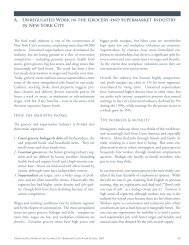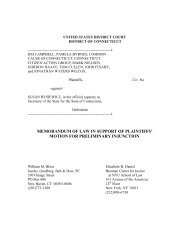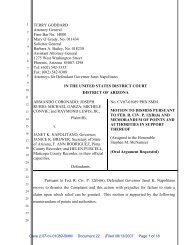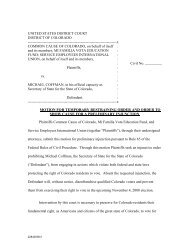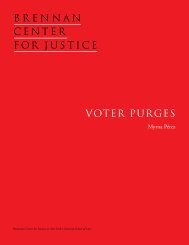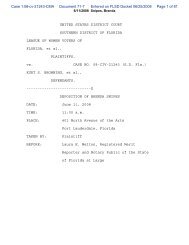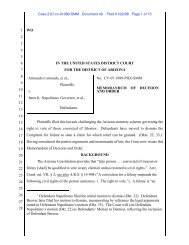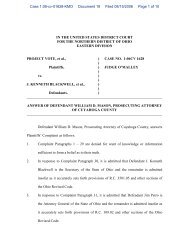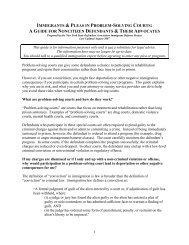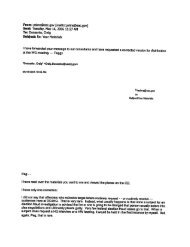View Publication - PolicyArchive
View Publication - PolicyArchive
View Publication - PolicyArchive
- No tags were found...
Create successful ePaper yourself
Turn your PDF publications into a flip-book with our unique Google optimized e-Paper software.
Betty Fussell agreed: “As everything hastightened up, the definition of intellectualproperty applies to everything. Have I foughtpublishers on this! Because it was the publisherswho were saying you have to get permission forany reference to a recipe. And I said, ‘that’s nottrue.’ I got somebody to look up the law in theCopyright Office. It says that how-to manualsof instruction are exempt from copyright.Because it’s shared knowledge. How to fix abicycle tire – that cannot be copyrighted. Andrecipes are the same. 113 The nature of recipes isshared oral knowledge.”Women Make MoviesNine members of Women Make Moviesmet on April 14, 2005. Jason Wulkowicz is adocumentary filmmaker who, with his wife,is working on their first independent film.Faith Pennick is a director and producer ofdocumentary and narrative films. Laura Poitrasand Samantha Farwella are also documentaryfilmmakers. Michelle Coe is the ProductionAssistance Program Coordinator of WomenMake Movies. The four other filmmakers askedto remain anonymous.Our four anonymous participants were alsothe most specific in describing experienceswith fair use. Their desire for confidentialitymay reflect the particular difficulties faced bydocumentary filmmakers, whose work typicallyincludes historical photos, relevant visual artand music, and trademarked logos or snatches ofsong played on a radio in the course of filming.Yet they are running a risk any time they failto get clearance. As one of the group recalled,“Going to film school, it was drilled into myhead you have to get people to sign everything.You have to get festival rights, get this, get that;it’s just automatic. No discussion of fair use infilm school.”Having learned little or nothing about fair useduring their professional training, and workingin a field with an intense clearance culture, theseartists were struggling to understand fair use.Wulkowicz expressed the experience of severalin the group: his first independent film is “aboutthe women who worked behind the scenes in thegolden age of television.” When he worked forothers, he said, licensing was mostly “somebodyelse’s problem. Now, dangerous new waters. Wefinished shooting, so we’re in editing now. We’remaking decisions about what we can and can’t use,and another factor that comes into it. With thefair use side of things, do you purposely alter yourwork so that you have somebody commenting onwhat’s being seen, just so that you can use it, asfair use?”He explained: “If you have somebody whoworked on a Studio One broadcast, and it’spart of a montage of a series of works that thiswoman has directed, but she doesn’t mentioneach one specifically, or talk about that episode,then it seems like it’s harder to argue fair use,and so, in order to try and tell a story about thisperiod, do you need to make everything into alittle vignette: ‘oh, I remember when so and sotripped on a hammer’?”“We’re thinking fair use as a last resort, ’causeit’s too tricky, and because as soon as you ask forpermission, you don’t want to just say, ‘well, we’regoing to do fair use anyway.’ Our first approach isto ask permission.”Faith Pennick was also in post-production,“on a documentary that I directed called SilentChoices,” and was dealing with the copyright issuesfor the first time. She thought perhaps fair useapplied to “a spontaneous news event and you’rethere with a camera. Then, as far as the people orthings that are in the frame of what you capture,people can’t say, ‘Well, you can’t use that, ’cause Ididn’t sign.’” Then she asked, “or is that differentfrom fair use? If you’re trying to get footage forsomething, as opposed to using the footage thatyou shot without getting release forms signed?”One of our anonymous participants had aclearer understanding, based on an experience withPBS: “If your use of the material is commentingon the subject of that material, it’s fair use. Forinstance, I worked on a PBS show that wasabout independent film, and we showed a clipfrom every filmmaker’s work, because we werecommenting on that work. We were interviewingthem or having discussion about it. We did notget clearances. Our lawyer looked at it and felt itwas fair use.”One of her colleagues responded, based onreadings she had found on the Internet: “If it’s18 Will Fair Use Survive?



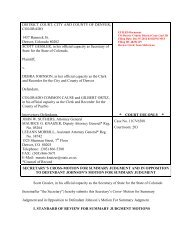
![Download the Letter [PDF] - Brennan Center for Justice](https://img.yumpu.com/50139248/1/190x245/download-the-letter-pdf-brennan-center-for-justice.jpg?quality=85)
